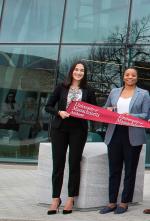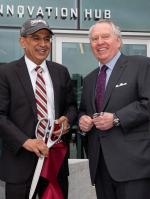Grand Opening of the Business Innovation Hub
April 19, 2019
Isenberg’s April 12th ribbon-cutting ceremony for its state-of-the-art Business Innovation Hub was a milestone in the school’s seven-decade history. With its extended community of students, faculty, and alumni in full force, the event celebrated the 72,000-square-foot, publicly and privately funded building that has changed the face of Isenberg, nearly doubling its usable space.
The Hub offers new technology-enabled classrooms, including a business analytics lab. New interview rooms expand the crucial Chase Career Center. And the Hub’s breakout rooms and expansive Learning Commons offer students unprecedented social and study space.
Before the outdoor ribbon cutting, the celebrants assembled in the Learning Commons for a forty-minute program highlighted by messages from key members of the Isenberg and UMass Amherst communities. Emceed by Senior Lecturer of Accounting Catherine West Lowry ’96, ’01MBA, the event featured remarks from Chancellor Kumble R. Subbaswamy, Building Authority Chair Victor Woolridge ’80, Isenberg Interim Dean Tom Moliterno, and Associate Dean Nefertiti Walker. It also offered inspiration from building co-architect Bjarke Ingels and from Katarina Maric ’19, an Isenberg Operations & Information Management major.

The Innovation Hub will augment Isenberg’s stature as a role model for diversity and inclusion, observed Nefertiti Walker, Isenberg’s Associate Dean for an Inclusive Organization. It offers catalyzing space for more “agile, open-minded, collaborative leaders” who will serve “more diverse customers.” In addition, it gives students a “safe space where they can challenge the ideas of others and grow.”
Connecting the Hub’s interior and the surrounding campus was a key aspiration, observed the building’s co-architect, Bjarke Ingels, whose firm, Bjarke Ingels Group, teamed up with Goody Clancy, a second prominent architectural firm. Ingels described the Learning Commons as “an aspirational room—a space to come up with big ideas.”

Five years ago, Isenberg began planning for the building, recalled Interim Dean Tom Moliterno. “I said, ‘This could be the most beautiful building in the world, but if it doesn’t work for our students, it will be a failure.’” It does work for students, and has so far yielded universal praise. “The Business Innovation Hub is a reflection of all that we have been and where we are headed,” he affirmed.
Alumni Impressions

Margery Piercey, a 1984 accounting graduate, couldn’t agree more. “It’s a fantastic space—incredibly energizing for the students,” she remarked. “And the building sends a message to employers that we and our students are top-notch.
“It’s the capstone to a great academic foundation,” noted 1978 graduate and major building donor Ed Shirley. I’ve often said that, as a business school, Isenberg is investment grade. The building reinforces that—all the impressive things that Isenberg has and will accomplish.
“I’ve run workshops in a lot of class- and meeting rooms,” observed 2013 MBA graduate Michele Equale. “You normally need to anticipate stress and worry over the technical equipment. There was none of that when I recently facilitated a workshop in the new building. It was the right space. It was plug-in and go.
“The Learning Commons gives students all the open space that they could want,” observed 1976 accounting graduate Tom Ackerman. “When I was a student, the old building offered no place to go. I also love the way that the architecture pulls the building into the center of the campus,” he continued. A key donor to the Hub, Tom applauded the building’s student focus. “I was incredibly moved by the student speaker’s sincerity and pride.”









